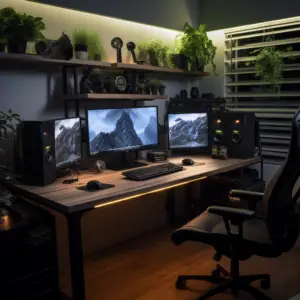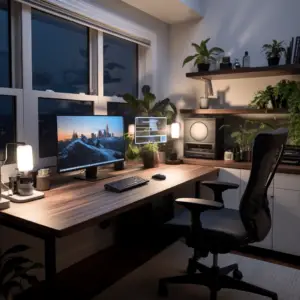Table of Contents
Introduction to the Importance of a Home Office Setup
Home office setup: Creating an effective home office is essential. It provides a space where you can focus without distractions. It helps to create a professional work environment.
Having a designated work area also allows you to separate personal and professional life. This helps to manage time and avoid distractions.
Ergonomics is important too. Investing in an ergonomic chair and proper desktop/laptop positioning can improve comfort and reduce musculoskeletal risks. Having a well-organized workspace also enables easy access to tools, documents, and equipment.
A thoughtfully designed home office makes a positive impact on your mental well-being. Suitable lighting, ventilation, and decor create a calm and focused mindset. Personalizing your workspace with inspiring items can boost motivation and creativity.
Harvard Business Review studies show that those with a designated remote workspace are more productive. Investing time and effort into a home office setup yields benefits for personal growth and professional success.
Key Elements of an Effective Home Office Setup

A great home office is a must for success and comfort. Three factors to consider:
- Furniture that is comfy and ergonomic. Get a supportive chair and a desk at the right height. Avoid pain in your back, neck, and wrists.
- Good lighting. Illuminate the workspace with natural or artificial light that reduces eye strain.
- Organizational tools. Keep everything in its place with storage shelves, filing cabinets, or desktop organizers.
Also, remember:
- Layout of the room.
- Minimizing distractions.
- Adding plants for a zen vibe.
- Personalize it to make it inspiring.
Thanks to technological developments, remote work is more popular than ever. Companies now understand the advantages of their employees working from home. Home offices are perfect for work-life balance and productivity.
Tips for Creating a Productive and Distraction-Free Home Office Environment
Transform your home into a productive workspace with these easy tips!
- Designate a specific area in your home for your office.
- Invest in comfortable and ergonomic furniture.
- Ensure the lighting is good by placing your desk near a window.
- Minimize distractions by decluttering your workspace.
- Create a schedule to stay focused and set boundaries with housemates.
- Add small touches that inspire creativity and motivation.
- Customize your setup based on what works best for you.
Start implementing these tips now and watch your productivity soar! Enjoy the comforts of home while thriving professionally with the perfect work environment. Technology can be your biggest ally or your most annoying reminder – so make sure to customize your setup for the best results!
Technology and Connectivity in a Home Office Setup
Tech and connecting are necessary for a good home office. The right tools and internet make it easier to work and talk with colleagues and customers. Let’s look at the elements for success.
Device: Laptop/Desktop. Allows tasks, video calls, data management. It’s a must.
High-Speed Internet: For browsing, sharing files, and video conferencing. Vital for communication and workflow.
Printer/Scanner: Printing, signing, scanning, faxing. Helps with documents and legal stuff.
Voice Over IP (VoIP) Phone System: Uses the internet. Cost-effective for short or long-distance calls.
Design your home office with the latest trends, but don’t forget to do work in it too.
Designing a Comfortable and Aesthetically Pleasing Home Office Space
Creating a comfy and attractive home office is essential for success. Here’s what to think about:
- Get a comfy chair and ergonomic desk to keep your body in good shape.
- Pick a color scheme that boosts focus and motivation, like calming blues or energizing greens.
- Let natural light in by situating your desk near a window, or use task lighting with warm LED bulbs.
- Organize your stuff efficiently with storage solutions such as shelves or file cabinets.
It’s also important to personalize your space with elements that show off your personality and interests. Throw in some artwork, plants, or motivational quotes to make an inspiring atmosphere. Balance functionality and beauty for the best outcome.
The tradition of designing the perfect home office dates back to the Renaissance period. During this time, scholars revered the importance of a conducive work environment. They decorated their studies with elaborate furniture and artwork to lift inspiration and brains. Now, we do the same by recognizing the worth of making our own personal havens where we can excel professionally and be surrounded by beauty.
Efficient Organization and Time Management Techniques for a Home Office
Set priorities to manage tasks well, without feeling stressed. The Eisenhower Matrix can help sort tasks by their urgency and importance. Delegate unimportant tasks to gain more time for crucial ones.
Take regular breaks throughout the day. Short ones can be used for relaxation or physical activity, to refresh mind and body.
Create a routine; start work at the same time each day. This will condition the mind to stay focused during those hours.
Make sure your workspace is ergonomic; invest in an adjustable chair and desk. This reduces fatigue and strain on the body.
Task management apps and software are great for keeping track of assignments and deadlines. They can give reminders and notifications to help stay organized and meet deadlines.
Implement these techniques in your home office setup to stay productive and still enjoy the comfort of home.
Maintaining a Healthy Work-Life Balance in a Home Office Setup

- Create a workspace: Allocate an area in your house just for work, away from living quarters. This helps make boundaries and show when work starts and ends.
- Set up routine: Establish fixed work hours to maintain balance and avoid overworking. Have regular breaks and make time for other activities to energize and steer clear of burnout.
- Take care of yourself: Look after physical and mental health by incorporating exercise, nutritious meals, and enough rest in daily routine. Make time for hobbies or relaxation outside of work time.
- Set limits with others: Convey clearly with housemates or relatives about your work schedule to reduce distraction. Set expectations and limits to ensure distraction-free work time.
- Remember that remote work provides flexibility but also needs discipline. By using these practices, you can keep a healthy balance between work and personal life in a home office setup.
- Also, add ergonomic elements such as a flexible chair or standing desk to improve comfort during lengthy hours at the home office setup.
A study conducted by Institute for Employment Research found that having a healthy work-life balance in a home office setup leads to greater productivity and job contentment (source: IER study). This highlights the importance of prioritizing this aspect while working from home.
Conclusion: Creating the Perfect Home Office Setup for Optimal Productivity and Well-being
Setting up the perfect home office is important for work and health. Add comfortable furniture and good lighting to the area to make it work better. Keep it clean and make it your own to make it feel comfortable. Plants and scents that make you feel good can help your creativity and happiness. A well-designed home office not only helps you get more done, but it also helps you feel better overall.
Start by finding a quiet place in your home where you won’t be interrupted. Get a nice chair and a desk that you can change the height of so you can sit or stand. Natural light is best, but LED lights with warm tones are also good. Give everything a place to go to reduce mess. Put artwork or words there to make it your own.
Include plants and smells that make you feel good. Plants clean the air and make you feel less stressed, and you can use candles or diffusers to spread the smell of lavender or peppermint.
Take cues from notable writer Ernest Hemingway’s writing routine. He was known for his attention to detail. Starting early, he worked at a standing desk with a typewriter and pencils.


